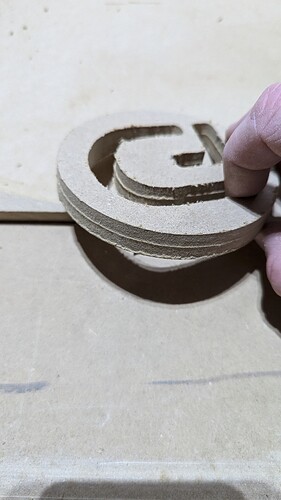TLDR - I think you are using the wrong bit
Caveat - I’m somewhat new to a lot of this myself, so if someone spots any mistakes, please jump in to give a better answer.
Having the proper chip load is important for tool life. Too big and the load on the bit can wear out or break the bit. Too small is worse, as it will “rub” rather than cut, leading to overheating and dull the tool quickly.
Here is a chart for recommended chip load ranges from Chip Load: Guide for Beginners - MellowPine The recommendations are based on a DOC = bit diameter, with a 25% reduction for 2x and a 50% reduction for 3X bit diameter DOC.
Note that these are not specific to your bit. If the manufacturer has provided specifications (most don’t), then use those instead.
| Material |
1/8″ tool |
1/4″ tool |
3/8″ tool |
1/2″ tool |
| Hardwood |
.003”–.005” |
.009”–.011” |
.015”–.018” |
.019”–.021” |
| Softwood/ |
|
|
|
|
| Plywood |
.004”–.006” |
.011”–.013” |
.017”–.020” |
.021”–.023” |
| MDF/Particle |
|
|
|
|
| board |
.004”–.007” |
.013”–.016” |
.020”–.023” |
.025”–.027” |
| Hard plastic |
.002”–.004” |
.006”–.009” |
.008”–.010” |
.010”–.012” |
| Soft plastic |
.003”–.006” |
.007”–.010” |
.010”–.012” |
.012”–.016” |
| Acrylic |
.003”–.005” |
.008”–.010” |
.010”–.012” |
.012”–.015” |
| High-pressure |
|
|
|
|
| laminate |
.003”–.005” |
.009”–.012” |
.015”–.018” |
.023”–.025” |
| Aluminum |
.003”–.004” |
.005”–.007” |
.006”–.008” |
.008”–.010” |
So for your 1/4" bit in MDF, your range would be .013-.016" per tooth (IPT). Because your build is on the lower end of rigidity (wide gantry, smaller/thinner tubes, printed plates), I suggest targeting the lower end of the range. Let’s call it 0.013 IPT. For metric, multiply by 25.4 for 0.330 mm per tooth.
The formula for chip load is CL = FR/(RPM x # of Teeth). where CL = Chip Load, FR = Feed Rate, RPM = Router Speed and # of teeth is how many flutes.
Solving for FR = CL x RPM x # of teeth we get
FR = 0.013 x 16000 x 2 = 416 IPM
Metric = 0.330 x 16000 x 2 = 10550 mm/min (approximate)
These are CRAZY numbers for the LR series machines, and there really is no way to achieve them, even by bumping up the maximum feed rate settings and increasing stepper current (which is NOT something that is recommended, especially for relative newcomers - myself included) which is why Ryan suggests using a 1/8" single flute bit for the LR3/LR4 machines.
Plugging in the numbers for a 1/8" single flute (carbide) bit into the equations gives us
FR = .004 x 16000 x 1 = 64 IPM
Metric = .1016 x 16000 x 1 = 1625 mm/min (27 mm/s)
These are much more attainable numbers. In fact, you could even bump up the RPM a bit and still stay within reasonable FR limits (reducing overall cutting time):
0.1016 x 20000 x 1 = 2032 mm/min (33.87 mm/s)
Note however, recommended DOC drops from 6mm per pass to 3mm/pass because of the 1x bit diameter DOC guideline, so the project may require more passes to get full DOC (you can go deeper, but you need to reduce the FR to compensate)
So I suggest buying several of the 1/8" single flute carbide bits from V1E website (or Amazon). The smaller diameter bits WILL break every now and then, so buy enough that you have them on hand for when that happens.
With the 1/8" bits, they will deflect more than the 1/4" bits will, so try to minimize the stick-out length as much as possible (push them as far into the collet as you can, while still maintaining the full flute cutting length)
Hope this helps (and I hope I haven’t made too many glaring mistakes)
